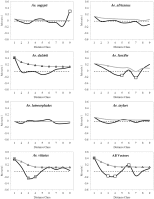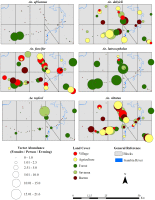Landscape ecology of sylvatic chikungunya virus and mosquito vectors in southeastern Senegal
- PMID: 22720097
- PMCID: PMC3373654
- DOI: 10.1371/journal.pntd.0001649
Landscape ecology of sylvatic chikungunya virus and mosquito vectors in southeastern Senegal
Abstract
The risk of human infection with sylvatic chikungunya (CHIKV) virus was assessed in a focus of sylvatic arbovirus circulation in Senegal by investigating distribution and abundance of anthropophilic Aedes mosquitoes, as well as the abundance and distribution of CHIKV in these mosquitoes. A 1650 km(2) area was classified into five land cover classes: forest, barren, savanna, agriculture and village. A total of 39,799 mosquitoes was sampled from all classes using human landing collections between June 2009 and January 2010. Mosquito diversity was extremely high, and overall vector abundance peaked at the start of the rainy season. CHIKV was detected in 42 mosquito pools. Our data suggest that Aedes furcifer, which occurred abundantly in all land cover classes and landed frequently on humans in villages outside of houses, is probably the major bridge vector responsible for the spillover of sylvatic CHIKV to humans.
Conflict of interest statement
The authors have declared that no competing interests exist.
Figures






References
-
- Chevillon C, Briant L, Renaud F, Devaux C. The Chikungunya threat: an ecological and evolutionary perspective. Trends Microbiol. 2008;16:80–88. - PubMed
-
- Diallo M, Thonnon J, Traore-Lamizana M, Fontenille D. Vectors of Chikungunya virus in Senegal: current data and transmission cycles. Am J Trop Med Hyg. 1999;60:281–286. - PubMed
-
- Townson H, Nathan MB. Resurgence of chikungunya. Trans R Soc Trop Med Hyg. 2008;102:308–309. - PubMed
Publication types
MeSH terms
Grants and funding
LinkOut - more resources
Full Text Sources
Medical

